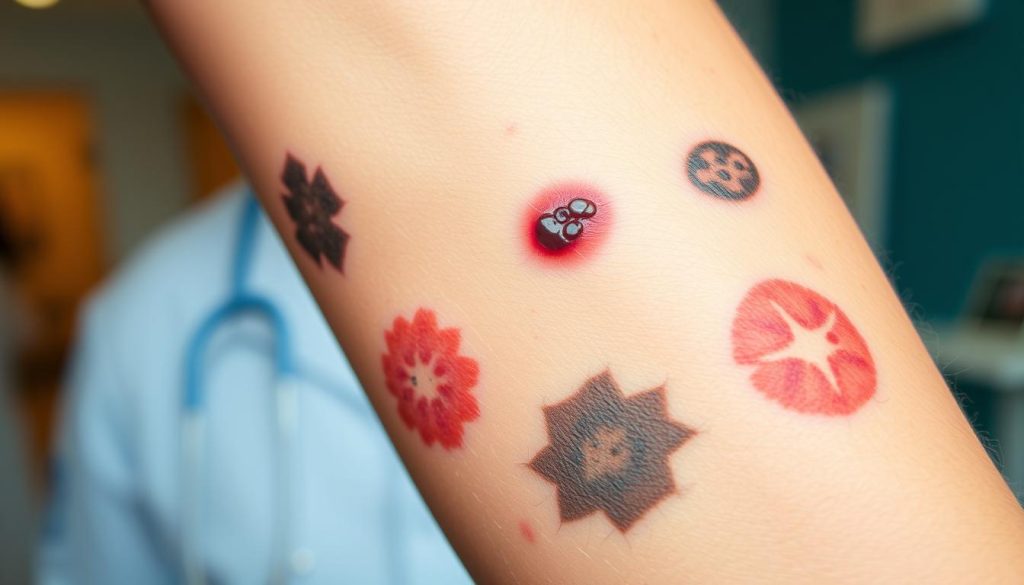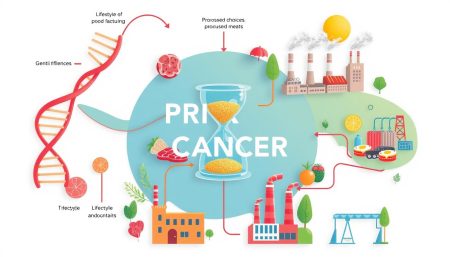We focus on the importance of catching skin cancer early. This is key to preventing it and improving treatment chances. Knowing the signs of melanoma and changes in moles is crucial in this fight.
Skin cancer affects many each year, but early detection can greatly improve treatment success. Let’s explore the early warning signs. The numbers show how crucial knowledge and early detection are for survival.
We’re on a journey of hope and resilience. This introduction is the first step towards beating skin cancer early. Let’s work together for a future where skin cancer is caught early and treated effectively.
Key Takeaways
- Understanding the critical need for early detection of skin cancer can save lives.
- Being vigilant about melanoma signs is essential for prompt action.
- Monitoring for unusual mole changes may lead to early diagnosis and better outcomes.
- Embracing stories of survivors emphasizes the life-saving power of awareness.
- Real-world statistics highlight the urgency of educating oneself on skin cancer symptoms.
Understanding Skin Cancer and Its Prevalence
Learning about skin cancer is key to reducing its risks. Knowing the basics helps people worldwide. Let’s explore the main types of skin cancer and its big impact.
The Basics of Skin Cancer
Skin cancer is a common cancer worldwide. It comes in three main types: basal cell carcinoma, squamous cell carcinoma, and melanoma. Each type starts in different skin cells, affecting treatment and outcomes.
Basal cell carcinoma is the most common. It starts in the skin’s basal cells. Squamous cell carcinoma begins in the skin’s upper layers. Melanoma, though rarer, is more dangerous. It comes from cells that make skin pigment.
How Common Is Skin Cancer?
Skin cancer is a big deal. It’s the most common cancer in the US, beating lung, breast, and prostate cancers. By age 70, 1 in 5 Americans will get skin cancer. This makes it a major health issue that needs constant attention and prevention.
Identifying Skin Cancer Symptoms
The first step in finding skin cancer early is to know the signs. Learning what to look for can help spot abnormal skin growths and signs of melanoma. This knowledge is key to staying healthy.
What Skin Cancer May Look Like
Skin cancer can show up in many ways. Knowing these signs is crucial for catching it early. Look out for:
- Asymmetrical moles or spots, where one half does not match the other
- Borders of spots are irregular, ragged, notched, or blurred
- Color variations from one area to another, with shades of tan, brown, black, white, red, or blue
- Diameters larger than a pea (greater than 6mm)
- Any new spot or mole that doesn’t look like others on your body
These signs can mean melanoma, a serious skin cancer. Catching it early is key to treatment success.
When To Be Concerned About Skin Changes
Not every skin change is a cause for worry. But, some symptoms need a doctor’s check. Here’s when to see a doctor:
- Any new growths or significant changes in existing moles
- Changes in symmetry, borders, or color of any skin lesion
- Any sore that does not heal
- Spot that becomes itchy, painful, or tender
- Spread of pigment from the border of a spot into surrounding skin
If you notice these changes, get a doctor’s opinion. It’s vital for early skin cancer detection.
| Potential Sign | Details | Action |
|---|---|---|
| New, expanding, or changing growth | Includes enlarging moles, or new, unexplained skin changes. | Consult a dermatologist for evaluation. |
| Persistent sores | Sores that continue to bleed, itch, or have not healed. | Professional examination necessary. |
| Red patches or shiny bumps | Could be indicative of basal cell carcinoma. | Immediate medical diagnosis advised. |
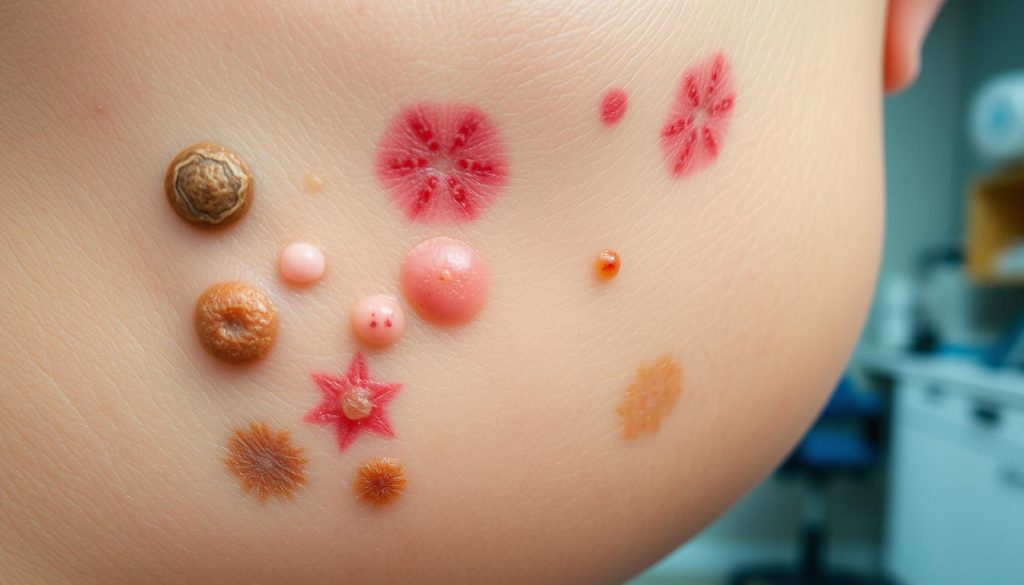
The Importance of Early Detection in Skin Cancer
Finding skin cancer early is key to better treatment and survival. Spotting precancerous skin conditions early can greatly improve health. This shows how crucial early detection is for survival rates.
Benefits of Early Diagnosis
Spotting skin cancer, especially melanoma, early can greatly improve chances of recovery. Studies show that finding melanoma early can lead to much better survival rates with early detection. Early action and treatment can stop cancer from spreading, saving lives.
Early Detection Methods
New tech in dermatology has made finding skin issues easier. Regular checks by doctors and self-exams are essential. Dermoscopy, a tool that looks at skin up close, helps find cancer that’s hard to see.
| Detection Method | Description | Benefits |
|---|---|---|
| Self-exams | Regular monitoring of one’s own skin for changes in moles and growths. | Enables early identification and timely medical consultation. |
| Clinical skin exams | Exams performed by dermatologists using advanced diagnostic tools. | Professional assessment that can detect subtle abnormalities. |
| Dermoscopy | A non-invasive skin imaging procedure using a dermatoscope. | Higher accuracy in distinguishing benign from malignant lesions. |
Adding regular skin checks to your health routine is important. This is especially true for those at higher risk or with a family history. It helps manage precancerous skin conditions and shows the value of skin health monitoring.
Recognizing Melanoma Signs and Symptoms
Being able to spot critical melanoma symptoms early can save lives. Malignant moles show different skin cancer warning signs than normal moles. We’ll look at these signs closely and show you what to watch for.
Critical melanoma symptoms include changes in size, shape, or color of moles. Unlike normal moles, which are usually the same color and symmetrical, bad moles are irregular, have many colors, and grow bigger. Itching or tenderness around a mole is also a warning sign.
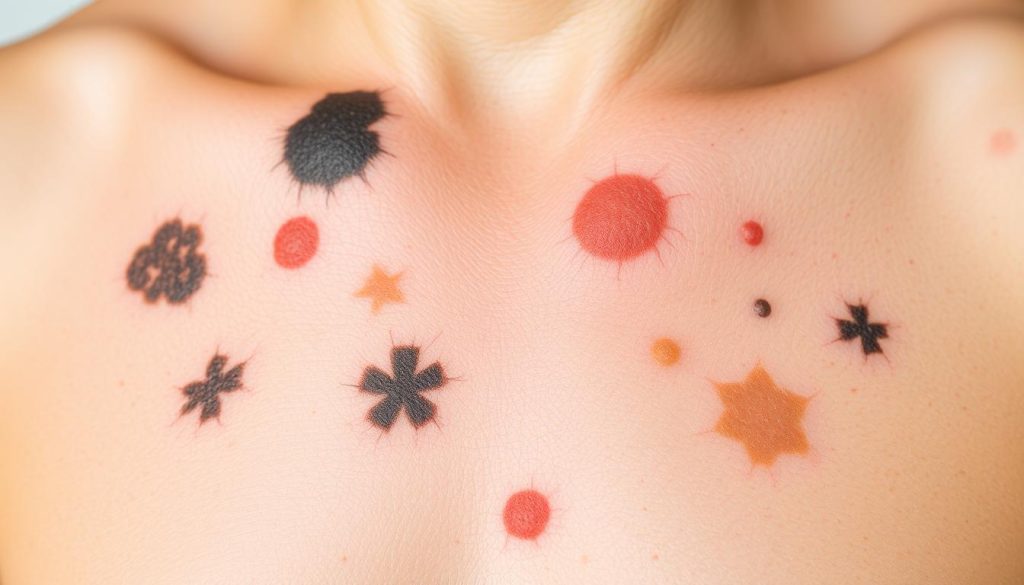
It’s important to know how malignant moles change. If a mole changes, showing any skin cancer warning signs, see a dermatologist. Below is a table that shows the difference between good and bad moles to help you spot melanoma.
| Characteristics | Benign Mole | Malignant Mole |
|---|---|---|
| Shape | Symmetrical | Asymmetrical |
| Border | Smooth and defined | Ragged or blurred |
| Color | Uniform color | Mixed colors or unusual patterns |
| Size | Stable size | Growth over time |
| Sensation | None | Itchy or tender |
Looking at these traits can help, but only a doctor can really tell if you have critical melanoma symptoms. If you see any signs of malignant moles or if your moles start to show skin cancer warning signs, get checked by a healthcare provider right away.
Types of Skin Lesions to Watch Out For
Lesions on the skin can be either harmless or serious. It’s important to watch for early signs of skin problems, like cancer. Knowing the difference between safe lesions and cancerous skin tags or unusual growths helps keep your skin healthy and ensures you get medical help when needed.
Distinguishing Between Benign and Malignant Lesions
Lesion analysis is key in figuring out what a skin lesion is. Doctors look at how the lesion looks, including its shape, color, and size. Benign lesions usually have smooth edges and the same color all over.
Malignant lesions, like melanoma, have rough edges, different colors, and grow bigger over time.
Common Characteristics of Suspicious Skin Lesions
Some skin lesions might look suspicious and need a closer look. Look out for lesions that are not symmetrical, have uneven colors, or are bigger than a pencil eraser. Regular self-checks are important in catching serious skin problems early.
If you notice any changes in your unusual growths, see a dermatologist right away. This can help catch cancer early, when it’s easier to treat.
| Characteristic | Typically Benign | Potentially Malignant |
|---|---|---|
| Border | Smooth | Ragged or Blurred |
| Color | Uniform | Non-uniform, Multi-Colored |
| Diameter | Less than 6mm | More than 6mm |
| Evolving | No change over time | Rapid changes |
Mole Changes That Signal Warning
Watching for changes in moles is key to catching moles and melanoma early. Knowing what changes might mean skin cancer is important. This part talks about the signs of suspicious moles and what they could mean.
ABCDEs of Melanoma Detection
The ABCDE rule is a simple way to check moles for melanoma. It helps spot harmful changes. Each letter in ABCDE stands for something to look for:
- Asymmetry: The mole is not even on both sides.
- Border: The edges are not smooth but are jagged or fuzzy.
- Color: The mole has different colors or shades, like brown, black, tan, blue, white, or red.
- Diameter: The mole is usually bigger than 6mm, but some can be smaller.
- Evolving: Any change in size, shape, color, or any of the above symptoms means you should get it checked.
Difference in Symmetry, Border, and Color
Changes in mole symmetry, border, and color are warning signs for melanoma. Here’s why it’s important to keep an eye on them:
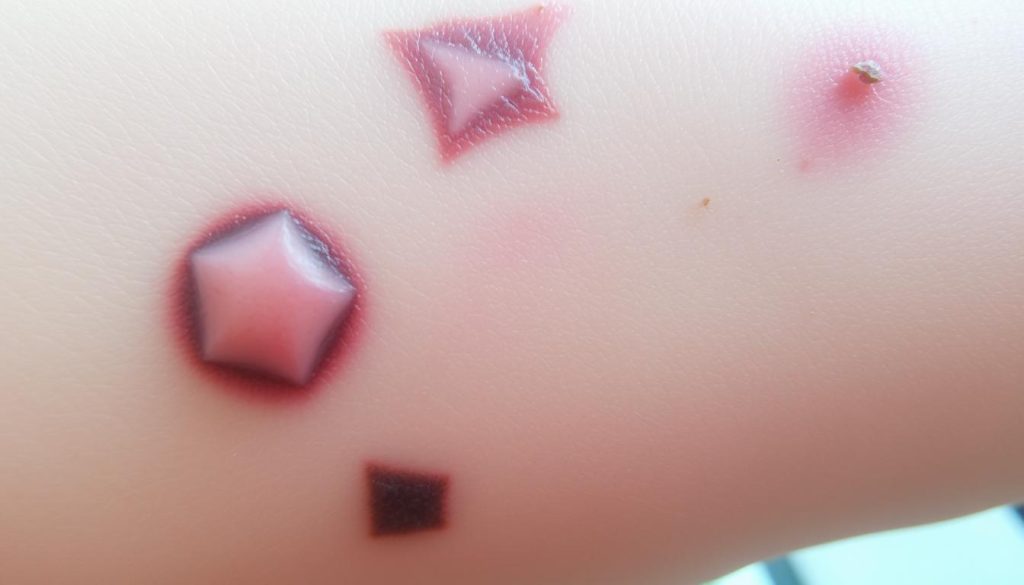
| Feature | Normal Mole | Suspicious Mole |
|---|---|---|
| Asymmetry | Mostly symmetrical | Asymmetrical |
| Border | Smooth | Irregular or blurred |
| Color | Uniform | Mixed shades |
Any change from the usual might mean a problem. It could be the difference between a harmless mole and one that’s a threat. If you see changes in asymmetry, border, or color, it’s a sign of skin cancer. These changes mean you should see a dermatologist.
Abnormal Skin Growths and When To Seek Help
It’s important to know the difference between harmless skin growths and skin cancer symptoms. Some skin changes need quick medical attention. We’ll look at different growths and when you should see a doctor.
Most skin growths like moles and warts are not harmful. But, watch for any new or changing skin spots. This is especially true if they change color, size, shape, or texture fast.
- Rapidly increasing in size: A growth that grows quickly over weeks or months needs a doctor’s check.
- Irregular border: Look for edges that are notched, blurred, or irregular. These could be signs of melanomas.
- Varying colors: Growths with many colors or uneven color distribution might be a melanoma warning.
- Itchiness, tenderness, or pain: If a growth hurts, itches, or bleeds, see a healthcare provider.
It’s wise to have any suspicious skin growth checked by a dermatologist. Early abnormal growth evaluation can lower the risk of skin cancer.
The table below shows the differences between harmless and possibly harmful growths. It helps you know when to get help:
| Characteristic | Benign Growth | Potentially Malignant Growth |
|---|---|---|
| Texture | Smooth | Rough, scaly |
| Color Consistency | Consistent | Multicolored or high variability |
| Evolution | Stable over time | Rapid changes in size or shape |
| Sensations | Typically none | Itchy or painful |
Regular self-exams and knowing dermatology warning signs are key to catching problems early. If you notice any alarming changes, see a specialist fast. Acting quickly can help prevent skin cancer from getting worse.
Key Skin Cancer Symptoms to Identify
When we talk about skin health, it’s key to know the signs of cancerous lesions. It’s important to act fast when you see these signs. This can help find cancer early and improve treatment chances.
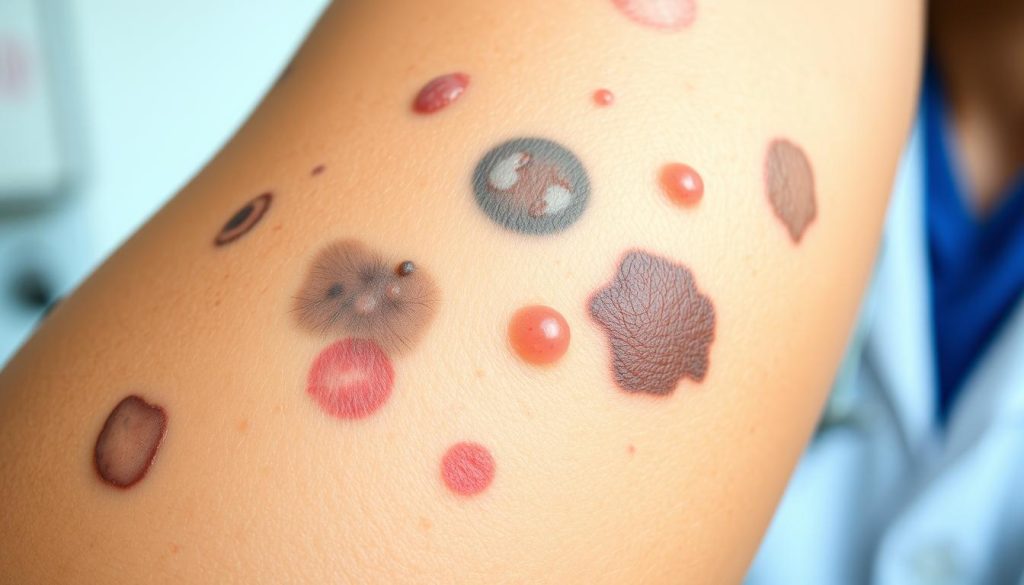
Skin cancer symptoms can be different for everyone. But, some signs are clear warnings to see a doctor right away. These include new growths, changes in moles, and sores that don’t heal in a few weeks.
- Asymmetrical Shape: Moles or spots with irregular shapes or that are noticeably different from others.
- Border Irregularity: Edges are typically uneven, notched, or scalloped where cancerous lesions are present.
- Color Changes: Diversity in color, ranging from shades of brown to black, sometimes pink, red, or white.
- Diameter: Skin spots larger than the size of a pencil eraser should be checked, especially if their size is changing.
- Evolving: Any lesion that changes in size, shape, color, or begins to bleed or itch.
Knowing these symptoms is crucial for good skin health and catching cancer early. Let’s look at three important signs in more detail:
| Symptom | Details | Example |
|---|---|---|
| Asymmetrical Shape | One half does not match the other half in shape, potentially indicating a malignant melanoma. | Moles differing in shape from one side to another. |
| Border Irregularity | Edges that are blurred, irregular, and show patches spreading into surrounding skin. | Spots with edges that are not crisp or clearly defined. |
| Color Changes | Includes various shades of brown or black, sometimes accompanied by patches of pink, red, white, or blue. | A mole that changes color or has more than one color. |
Spotting these signs early can help you get medical help fast. This can stop cancer from getting worse. Being aware and taking action early is key to fighting skin cancer. New medical tools help find cancer sooner, but knowing the signs is still the best defense.
Skin Discoloration and Cancer Correlation
Skin discoloration, from simple freckles to serious pigmented lesions, often raises concerns about melanoma risk. Not all skin changes mean cancer, but knowing which ones to watch is key.
Types of Skin Discoloration Linked to Skin Cancer
There are different skin color changes that could signal skin cancer. These include:
- Hyperpigmentation (darker skin patches)
- Hypopigmentation (lighter skin patches)
- Red skin lesions
- Black or brown spots that may evolve in shape or size
Dark pigmented lesions are especially worrying as they might be signs of melanoma.
Understanding Pigment Changes and Risk
New pigmented lesions or changes in moles can be due to genes or the environment. This increases the risk of melanoma. It’s vital to watch for any sudden or gradual skin color changes.
| Type of Discoloration | Potential Risk | Common Locations |
|---|---|---|
| Hyperpigmentation | Moderate | Face, hands, arms |
| Hypopigmentation | Low | General body |
| Red lesions | High | Body regions exposed to sun |
| Black/Brown spots | Very High | Moles anywhere on the body |
Knowing the signs of skin discoloration linked to risks can help catch skin cancer early. This can save lives by allowing for timely treatment.
What an Unusual Mole Appearance Could Mean
Changes in mole appearance can signal skin issues, like skin cancer. Knowing about mole evolution, spotting skin cancer signs, and keeping up with mole monitoring helps catch skin cancer early. This can lead to better treatment outcomes.
Variations in Moles and Their Significance
Moles can change in color, size, or shape. These changes might show something is wrong at a cell level. Doctors say these changes are key to checking skin health.
Tracking Changes in Moles Over Time
It’s important to watch moles for any unusual growths or changes. These could be signs of skin cancer. By checking your skin regularly, you can spot these changes early.
| Change to Monitor | Significance | Suggested Action |
|---|---|---|
| Color Variation | Possibility of melanoma | Consult a dermatologist |
| Increase in Size | Risk of cancerous growth | Immediate professional check-up |
| New Moles | Possible benign or malignant growth | Regular monitoring and professional advice |
| Change in Texture | Indication of evolving mole | Document and seek medical opinion |
Precancerous Skin Conditions You Shouldn’t Ignore
It’s important to watch for precancerous warning signs in your skin. Actinic keratosis is a big warning sign that shouldn’t be ignored. Catching these lesions early can help stop skin cancer.
Actinic keratosis shows up as rough, scaly patches, often in sun-exposed areas. They might look harmless at first, but they’re serious precancerous warning signs. People with fair skin, sunburn history, or lots of sun exposure are at higher risk. This makes it crucial to stay alert about skin health vigilance.
- Regular monitoring of skin changes
- Avoiding excessive sun exposure
- Using sunscreen with an appropriate SPF
Managing actinic keratosis is key to preventing skin cancer. Treatment options range from creams to procedures like cryotherapy. But the best defense is being aware and acting fast.
If you want to know more about cancer risks, including skin cancer, check out reliable sources. Learning about early signs can help improve treatment success. Find out more about early warning signs of different cancers here.
Ignoring actinic keratosis warning signs can lead to serious problems. It can turn a manageable condition into a tough fight against skin cancer.
| Condition | Appearance | Risk Level |
|---|---|---|
| Actinic Keratosis | Rough, scaly patches | High |
| Healthy Skin | Smooth, regular coloration | Low |
Talking about precancerous warning signs like actinic keratosis is vital. By focusing on skin health vigilance, we can help our communities stay healthy. This way, we can reduce the risk of serious diseases.
The Role of Dermatology Screening in Skin Cancer Prevention
Regular dermatology screenings are key in preventing cancer. These visits are more than just screenings. They are a vital part of preventative dermatology. Early detection by dermatologists can greatly reduce skin cancer risk.
Regular Check-Ups and Professional Analysis
Getting regular skin checks from a dermatologist is crucial. Unlike doing it yourself, a professional can spot small changes you might miss. Dermatologists use special tools to find skin cancer early, making these checks very important.
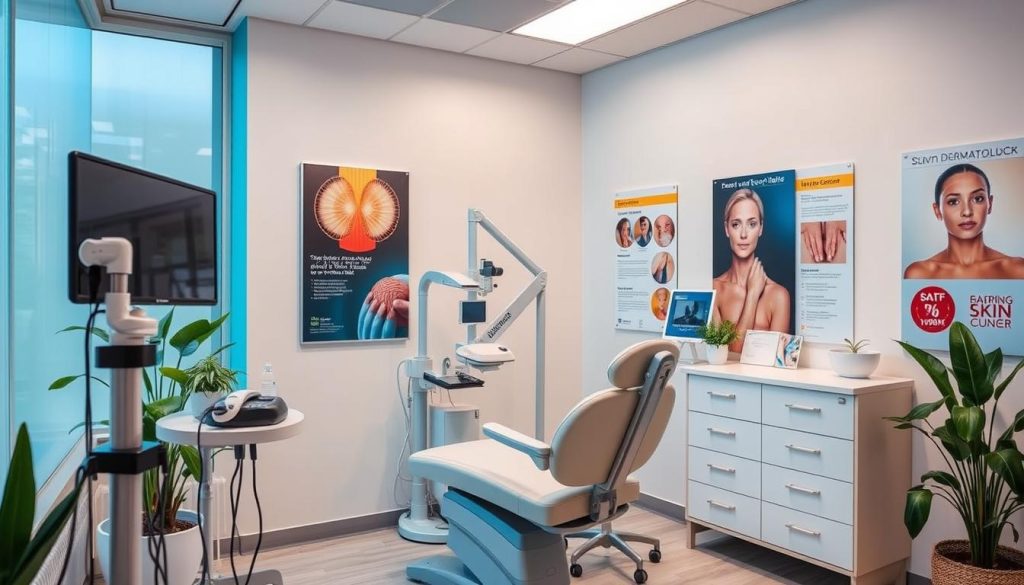
Self-Examination vs. Dermatological Exams
Doing self-exams is good for knowing your skin. But, they can’t replace a dermatologist’s thorough check. Dermatologists can find problems more accurately and start treatments early, which helps prevent cancer.
To stay healthy, it’s best to do both self-exams and get regular professional checks. This way, you can keep your skin in the best shape and help prevent skin cancer.
Advancements in Skin Cancer Diagnosis
The field of skin cancer diagnostics has made huge strides. It now uses new dermatology solutions and advanced cancer detection technology. These changes have moved us away from old methods to more accurate ones.
Modern Technology for Detecting Skin Cancer
New technology has greatly improved skin cancer detection. Tools like digital dermoscopy, AI, and high-resolution imaging find problems early and accurately. These tools make diagnosis faster and more reliable, helping to save lives.
Emerging Trends in Dermatology Screening
In dermatology, change is constant. Scientists and tech experts are always finding new ways to spot skin cancer early. They’re working on wearable devices and smart scans that watch for skin changes. This shows a future where tech and health care work together better.
| Technology | Description | Impact on Early Detection |
|---|---|---|
| Digital Dermoscopy | Uses digital microscopy to examine skin lesions, capturing and analyzing detailed images. | Increases the ability to detect skin cancers at their earliest stages. |
| AI Analysis Tools | Employs artificial intelligence to differentiate between benign and malignant lesions. | Enhances diagnostic accuracy, reducing the rate of unnecessary biopsies. |
| High-resolution Imaging | Provides ultra-clear views of skin layers to pinpoint subtle abnormalities. | Improves the detection of less-visible skin cancers, such as melanomas. |
Conclusion
As we learn more about skin cancer, it’s clear that empowerment through education is key. We’ve shared signs and signals to boost skin cancer awareness. This awareness can save lives.
By knowing how to spot changes in moles and skin, we can catch skin cancer early. Early detection is crucial for better treatment results.
We hope this life-saving knowledge gives you the tools and confidence to check your skin often. If you notice something odd, don’t hesitate to see a doctor. Early action is vital for beating this disease.
For more on spotting early signs of health issues like colon cancer in women, check out this link.
Sharing stories and resources helps those facing skin cancer. We’re with you, reminding you that you’re not alone. Together, we can make a difference in our health journey.
FAQ
Q: What are the early detection signs of skin cancer?
A: Look out for new or changing moles. Check for asymmetry, irregular borders, and different colors. Also, watch for moles that are bigger than a pencil eraser or changing over time. Regular skin checks are key.
Q: How common is skin cancer?
A: Skin cancer is very common, with millions diagnosed worldwide each year. While some types are less serious, melanoma is dangerous if caught late.
Q: When should I be concerned about changes in my skin?
A: Be worried if your skin changes last or are new. Watch for lesions that grow, change shape, or color. Also, be cautious of any growth that bleeds or won’t heal.
Q: What are the benefits of early diagnosis of skin cancer?
A: Catching skin cancer early can greatly improve treatment success. It can also mean less surgery and better survival chances. Early detection is crucial in fighting skin cancer.
Q: What are the ABCDEs of melanoma detection?
A: The ABCDEs are: Asymmetry, irregular Borders, Color variations, large Diameter (over 6mm), and Evolving nature. These help spot potential melanoma.
Q: What types of skin discoloration are linked to skin cancer?
A: Skin cancer can cause brown spots to black lesions. Any pigment changes, especially if irregular, should be checked by a dermatologist.
Q: How can tracking changes in moles over time help with early detection of skin cancer?
A: Tracking moles helps spot abnormalities early. This leads to timely medical advice and treatment, which can be life-saving.
Q: What are the signs of precancerous skin conditions?
A: Precancerous signs include rough, scaly patches on sun-exposed skin. They might be red, brown, or skin-colored and can itch or get inflamed. Always get any suspicious skin checked by a pro.
Q: How does dermatology screening contribute to the prevention of skin cancer?
A: Dermatology screenings catch early signs of skin cancer. Regular visits can spot pre-cancer and cancer early, when it’s most treatable. They work alongside self-exams.
Q: What are some modern technologies used for detecting skin cancer?
A: New tech includes digital dermoscopy for detailed skin checks and AI tools for analyzing skin images. These improve diagnosis accuracy.












